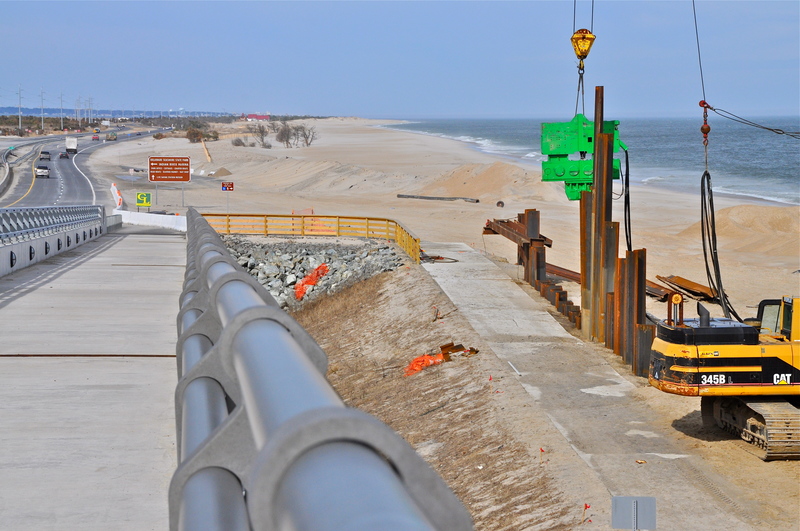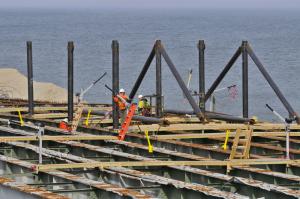Even as work progresses on a steel protection wall near Indian River Inlet bridge, state transportation officials say it's not a panacea to protect the integrity of approach road Route 1.
Transportation officials say the best protection for the road is a wide beach and stable dune, but these projects are outside of the Delaware Department of Transportation's jurisdiction, said Doug Robb, bridge project manager. That work falls under the auspices of the Department of Natural Resources and Environmental Control and the U.S. Army Corps of Engineers.
DNREC officials say it's unclear if funding for beach replenishment at the inlet was included in the recently passed $50.5 billion federal Sandy relief bill. DNREC spokesman Michael Globetti said the bill contains no earmarks for specific projects. Within the next month, he said, corps officials are expected to put together a list of priority projects for all states.
“In the long term, we need more sand,” Robb said. “It will require dredging miles of beach. Sand is our best friend, and we need lots of it. The wall is not the sole means of protection; it buys us time.”
The $2 million steel wall is an emergency measure designed to stabilize the roadbed of Route 1. DelDOT spokesman Geoff Sundstrom calls the wall the last line of defense. “We have to do whatever we can to protect this asset,” he said.
Work on the steel wall is scheduled to finished by early March; tie-backs to stabilize the wall will be completed in early April. “We will be in a much better situation than we are today,” Robb said.
Robb said money for the wall came from unspent funding for the bridge.
The steel wall will be covered by sand 30 to 40 feet below the surface in an effort to protect the roadbed from erosion. But, as transportation officials point out, the project is not designed to stop all road flooding in the event of a storm. In other words, installing the wall offers no guarantee that the bridge would not be closed again due to flooding.
Nature has not been kind
DelDOT's subcontractor was putting sand from the old bridge approaches back along the shoreline on the north side of the inlet when waves and storm surge from Hurricane Sandy washed it out to sea. After demolition of the old bridge, leftover sand from the previous road approaches will be used to resupply some sand on the inlet's sand-starved north side. Demolition is scheduled to be completed before Memorial Day, Robb said.
Even before waves and sand from Hurricane Sandy closed Route 1 and the bridge the last week of October, DelDOT officials were looking at options to protect the roadway, Robb said. He said state officials have seen the increasing effects of beach erosion and sea-level rise over the past few years. Dune erosion from the effects of Hurricane Irene in August 2011 forced state officials to close the approach road to the old bridge, and it also forced officials to look for a solution to stem erosion as the new bridge was set to open.
Robb said DelDOT officials had hoped that time was on their side to protect the roadway, but it turned out not to be the case when Hurricane Sandy came up the coast. “Two big storms within 12 months is rare,” Robb said. “This prompted us to take action.”
Robb said the solution had to provide the most protection possible, be cost effective and be completed quickly.
Of the options state officials put on the drawing board, stone armoring near the bridge seemed to offer the most protection, but a $10 million price tag put the project out of the realm of possibilities, Robb said. In addition, he said, it likely would have taken years to get permits to complete the project.
The next best option was construction of an 800- to 900-foot long steel wall buried 30 to 40 feet in the sand about 20 feet away from the roadway. Robb said similar projects have been successful in the Outer Banks of North Carolina.
DelDOT had been considering this project for several years, and ordered the steel before Thanksgiving to beat high demand for steel brought on by Hurricane Sandy destruction. “We had to act quickly or getting the steel would still be a couple of months away,” Robb said. “There was an immediate shortage of steel following Sandy.”























































